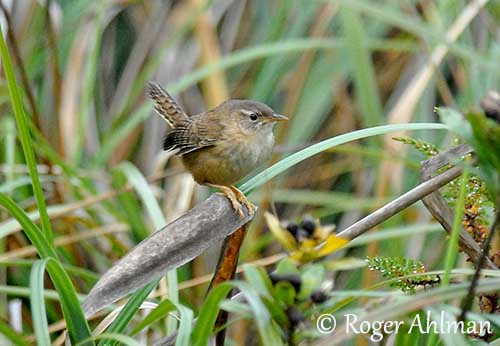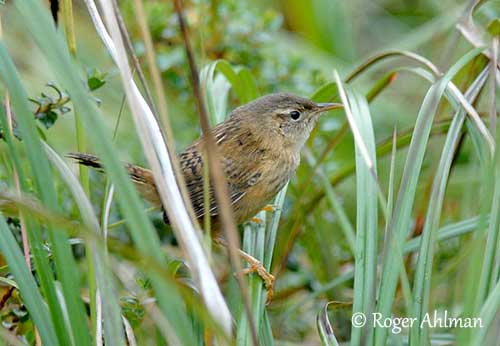
Fr: Troglodyte à bec court
Ang: Sedge Wren – Grass Wren, Short-billed Grass Wren, Short-billed Marsh Wren, Short-billed Marsh-Wren
All: Seggenzaunkönig
Esp: Cucarachero Sabanero - Chercán de las vegas, Chivirin sabanero, Chivirín Sabanero, Chochín Sabanero, Colchonero sabanero, Cucarachero Paramuno, Ratona aperdizada, Ratona de Ciénega, Ratonera Aperdizada, Saltapared Sabanero, Soterrey Sabanero
Ita: Scricciolo dei giunchi
Nd: Zeggewinterkoning
Sd: Starrgärdsmyg
Photographers:
Roger Ahlman
Pbase Galleries Peru and Ecuador
Ken Havard
My Bird Gallery & Flickr gallery 1 & Flickr gallery 2
Eduardo Andrés Jordan
MIS AVES – AVES DE ARGENTINA
Otto Plantema
Trips around the world
Text by Nicole Bouglouan
Sources:
HANDBOOK OF THE BIRDS OF THE WORLD Vol 10 by Josep del Hoyo-Andrew Elliott-David Christie - Lynx Edicions - ISBN: 8487334725
WRENS, DIPPERS AND THRASHERS by Brewer David – illustrated by Barry Kent Mackay- Yale University Press - ISBN: 0300090595
A GUIDE TO THE BIRDS OF MEXICO AND NORTHERN CENTRAL AMERICA by Steve N. G. Howell, Sophie Webb - Oxford University Press - ISBN: 0198540124
A GUIDE TO THE BIRDS OF COLOMBIA by Steven L. Hilty and William L. Brown - Princeton University Press – ISBN 069108372X
BIRDS OF SOUTH AMERICA – Passerines - by Robert S. Ridgely and Guy Tudor – HELM Field Guides – ISBN: 9781408113424
BirdLife International (BirdLife International)
What Bird-The ultimate Bird Guide (Mitchell Waite)
Animal Diversity Web (University of Michigan Museum of Zoology)
All About Birds (Cornell Lab of Ornithology)
Sedge Wren or Grass Wren
Cistothorus platensis
Passeriformes Order – Troglodytidae Family
INTRODUCTION:
The Sedge Wren usually frequents wet fields and marshes dominated by sedges and grass. Both English names, “Sedge Wren” and “Grass Wren” come from this type of habitat. This small bird is secretive and its cryptic plumage makes it difficult to spot among the marshy vegetation.
The different races can be identified by voice and habitat. However, this bird is always mainly buffy with streaked back and barred wings and tail. The southern birds have blacker crown and heavier streaking than the Andean birds which have browner crown and darker buff underparts.

DESCRIPTION OF THE BIRD:
Biometrics:
Length: 9-11 cm
Weight: 7-9 g
The adult of nominate race has blackish-brown crown, shoulders and back with pale buff streaks, whereas rump and uppertail-coverts are buffy-brown and less streaked.
On the upperwing, the coverts are buff-brown and slightly streaked buff. Primary and secondary’s pattern forms conspicuous bars on closed wings. The tail is buff-brown with darker bars.
The underparts are buffy-white with slightly darker breast and orange-buff on flanks and lower belly.
We can see a conspicuous buffy supercilium.
The bill is blackish above and yellowish below. The eyes are dark brown. Legs and feet are dark brown.
Both sexes are similar.
The juvenile shows less white streaks above and is paler below.
SUBSPECIES AND RANGE:
The Sedge Wren has complex taxonomy and numerous subspecies throughout the Americas. But the 18-20 recognized races form three geographical groups:
Stellaris group occurs in North America S to Panama.
Aequatorialis group is found in NW South America, from Colombia E to Guyana and S to Bolivia.
Nominate group Platensis occurs S South America from N Argentina and SE Brazil, S to Tierra del Fuego.
There are 18-20 subspecies according to the authors. They differ in plumage colour (more or less rufous) and streaking. Vocalizations and habitat type can help too.
As all the Troglodytidae species, the Sedge Wren cocks its tail over the back and flicks it from side to side.
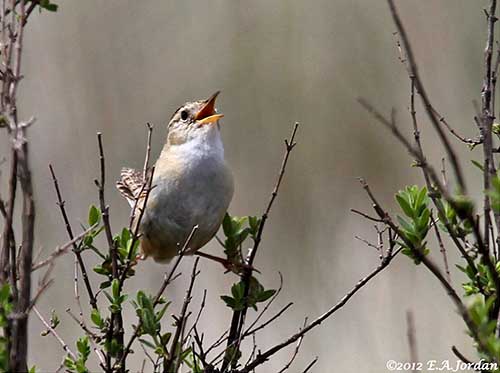
HABITAT:
The Sedge Wren of N America favours the wet areas and usually breeds in sedge meadows and other wet grasslands, marshes, bogs, ponds areas and coastal wetlands. It avoids open areas.
The species of S America frequents a variety of habitats such as open grass savanna, partially flooded Alnus forest, bamboo bogs, wet high grassland, dry grassland too, borders of tidal marshes according to the range from N to S of South America.
In Falkland Islands, the race “falklandicus” frequents tussac grassland with Poa flabellata.
The Sedge Wren can be seen from sea-level up to 4000 metres of elevation.
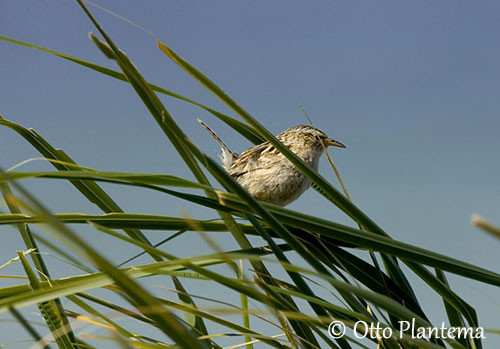
CALLS AND SONGS: SOUNDS BY XENO-CANTO
The Sedge Wren of N American populations utters series of dry notes, accelerating and ending in a trill “chip-chip-chip-chip-chipchipchip-chrchrchrchr” often given from a concealed perch.
The call is a sharp “chip” or “chip-chip”, and we can hear scold “churrr, wrrrt”.
The songs of the S American populations are different. The Andean birds give short, discrete phrases “sisisi, trrr, chee-ee-ee-ee-ee” followed by pauses.
The race “falklandicus” utters a pleasant series of undulating notes and warbles “siu-siu-siu” and “cli-cli-cli” separated by a low trill.
The song varies according to the range and the race, but usually consists of repetitions of gurgles and trills.
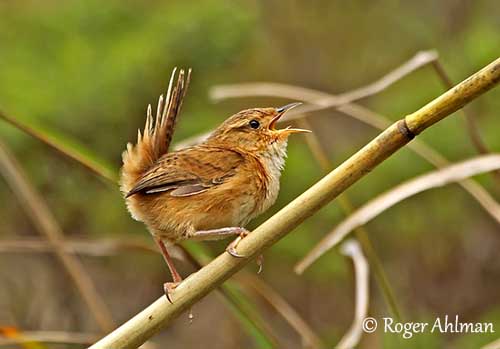
BEHAVIOUR IN THE WILD:
The Sedge Wren is mainly an insect eater, and feeds on insects and spiders. It forages usually on the ground at base of grasses and sedges. The preys include spiders and various insects such as ants, lady beetles, butterflies, moth larvae and grasshoppers.
There is little information about the breeding behaviour of the Sedge Wren. The pairs form on the breeding grounds. The male arrives first, about two weeks before females. It establishes the nesting territory.
The pairs can be monogamous, but the male may also attracts more than one female, often two, to its territory. It builds several nests and the female chooses one of them.
During the breeding season, the territorial males can fight. They often perch at top of bushes or shrubs and sing at each other. When breeding, their complex and musical songs reveal their presence as they perch in a somewhat exposed situation. They are usually seen in loose colonies.
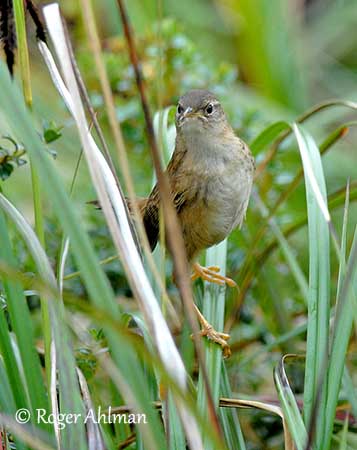
The birds of the Stellaris group of N America (race stellaris) are highly migratory and travel by night. Other populations including Mexican and Central American races of the Stellaris group are sedentary, and the S American populations too.
The race “hornensis” from Cape Horn may be somewhat migratory from some observations.
The race “falklandicus” is resident on Falkland Islands.
The flight is weak with rapid wingbeats. When flushed, it flies only a short distance to reach the vegetal covert into which it directly dives. During the flight, the wings are vibrating as the bird seems to float above the ground.
REPRODUCTION OF THIS SPECIES:
The breeding season varies according to the range. The northern races of Stellaris group breed between May and September. The Aequatorialis group of southern range breeds during an extended season from February to August, but this period depends on the region. The race “falklandicus” breeds in October/December and produces only one brood.
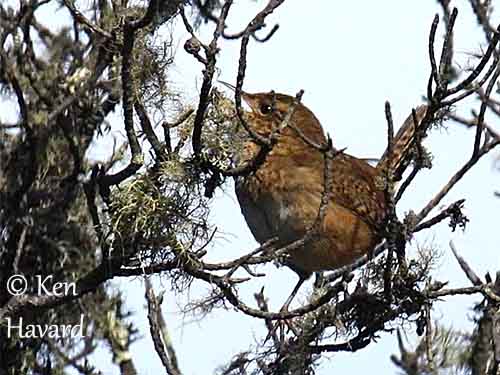
In Stellaris group, the male builds several nests, but the female chooses one of them and adds the lining. This is a globular structure with a side entrance. It is made with fine grasses and sedges interwoven with plant down. It is lined with feathers, down and soft grasses. It is placed in tall grasses and sedges, about 25-50 centimetres above the ground. The nest is often in close proximity to wet areas.
The race “falklandicus” builds a bowl of grass lined with white feathers or wool. It is placed between 30 and 110 centimetres above the ground.
Most of southern races build a large ball-like nest with grasses, concealed near the ground in tall grasses.
The female lays 4-8 white eggs for the first brood, and mainly 5-6 for the second brood. She incubates alone during about 13-16 days, and the chicks are fed by their mother, although the male may sometimes take part in this work, but rarely. The young birds fledge 12-14 days after hatching and remain in the nest area until the fall migration.

PROTECTION / THREATS / STATUS:
The Sedge Wren has wide range where it can be fairly common to uncommon. It is currently evaluated as Least Concern for the global population, but depending on the range, the status may vary and it is currently considered Endangered, Threatened or of Special Concern in N America. There is no information about Central and South American Populations. In Falkland Islands, the population is estimated at about 2,000 breeding pairs.
